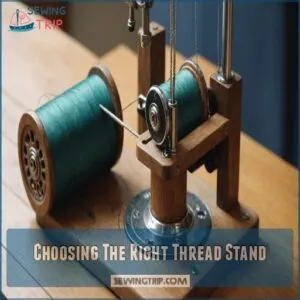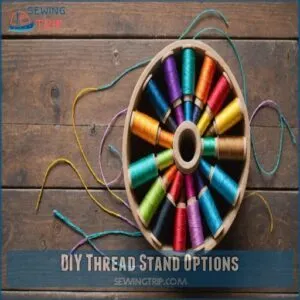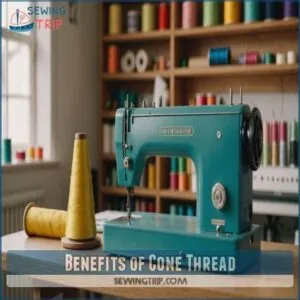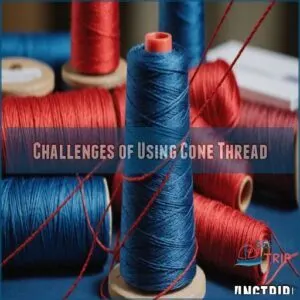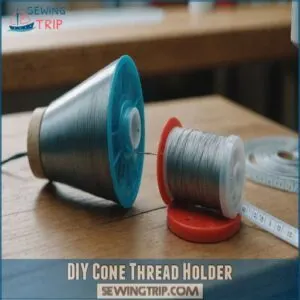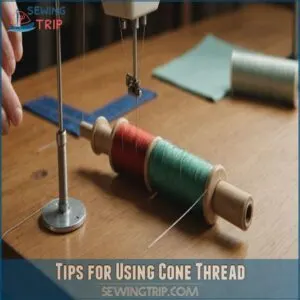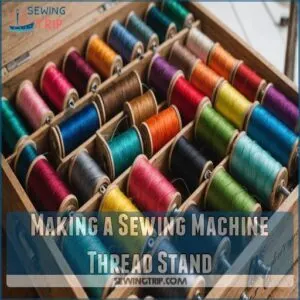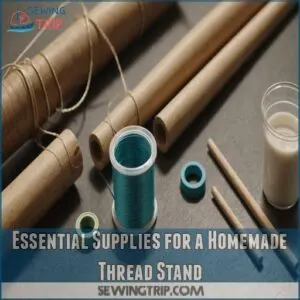This site is supported by our readers. We may earn a commission, at no cost to you, if you purchase through links.
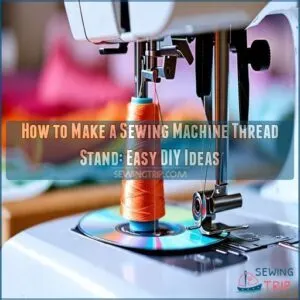 You can easily make a sewing machine thread stand with items you probably have at home.
You can easily make a sewing machine thread stand with items you probably have at home.
Grab a paperclip, some tape, and a CD holder, mug, or small bowl.
Bend the paperclip into a U-shape and tape it to the back of your machine.
Place your cone thread on the CD spindle or in the mug, then thread it through the paperclip and into your machine.
Voilà! You’ve just created a DIY thread stand that’ll keep your thread feeding smoothly and prevent tangling.
This nifty hack saves you money but also gives you control over your sewing setup.
Who knew a paperclip could be such a game-changer?
But that’s just the tip of the thread spool…
Table Of Contents
- Key Takeaways
- Benefits of a Sewing Thread Stand
- Choosing The Right Thread Stand
- DIY Thread Stand Options
- Benefits of Cone Thread
- Challenges of Using Cone Thread
- DIY Cone Thread Holder
- Tips for Using Cone Thread
- Making a Sewing Machine Thread Stand
- Essential Supplies for a Homemade Thread Stand
- Frequently Asked Questions (FAQs)
- Conclusion
Key Takeaways
- You can easily create a DIY sewing machine thread stand using common household items like paperclips, tape, and CD holders or mugs.
- A thread stand allows you to use cost-effective cone thread, which provides more yardage and a wider variety of colors than standard spools.
- When designing your thread stand, focus on stability, smooth thread feeding, and proper tension management to prevent tangling and breakage.
- Experiment with different materials and designs to find the best thread stand solution for your specific sewing setup and needs.
Benefits of a Sewing Thread Stand
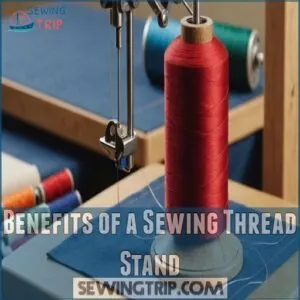
Using a sewing thread stand, you’ll save money by accommodating larger, cost-effective cone threads while preventing annoying tangles and breakage.
It also handles different spool sizes, making your sewing experience smoother and more efficient.
Cost-Effective Option With Cone Thread
You’ll love the cost savings of cone thread! Think of it: one cone holds way more thread than those tiny spools, meaning fewer trips to the store.
Bulk buying tips are key; look for sales and consider sharing with friends.
Clever storage solutions, like a DIY thread stand, keep your workspace organized.
Explore cone thread types – there’s a perfect one for every project.
A cone thread holder, whether store-bought or DIY, is a must-have for easy access.
You’ll master your sewing game with this cost-effective approach.
Smooth Thread Feeding and Reduced Breakage
After considering cost-effectiveness and ensuring proper thread tension with a thread guide system, think about how a sewing machine thread stand helps smooth thread feeding and reduces breakage.
Here’s why it’s valuable:
- Thread tension stays consistent, avoiding those frustrating breaks.
- Prevents tangles, thanks to a smooth flow from the spool.
- Enhances needle quality with less strain, minimizing issues during sewing machine maintenance.
Accommodating Different Spool Sizes and Types
Imagine this: you’ve got a variety of threads to choose from, like cotton, polyester, and cotton-wrapped polyester threads, each with its own strengths and ideal projects, such as choosing the right thread. you’ve got a sewing thread stand that effortlessly handles any spool type or size, from cones to cops.
With features designed for versatility, it becomes your thread organizer, ensuring smooth sewing and preventing pesky tangles.
Embracing such creativity empowers your designs, as you explore every thread stand review and tutorial to make informed choices.
Choosing The Right Thread Stand
When choosing the right thread stand, consider the size and shape of your spools to make sure it fits properly and is easy to use.
Make sure it’s sturdy with a weighted base to avoid tipping, so you can sew without interruptions.
Considering Spool Size and Shape
Let’s explore how spool size and shape affect your thread stand choice.
Consider how these elements impact:
- Spool width: Affects how thread unwinds.
- Thread weight: Lighter threads may need less tension, and it’s important to follow the machine’s recommended thread weights to avoid damaging it, as outlined in guidelines for machine compatibility.
- Spool diameter: Bigger spools require more space.
- Cone size: Larger cones mean longer sewing sessions.
- Bobbin compatibility: Makes sure sewing runs smoothly.
Keep these factors in mind for good sewing machine thread management.
Accommodating Cross-Wound and Stacked Thread Spools
Thread stand design is important when accommodating cross-wound and stacked thread spools.
You’ll want a holder that provides smooth, consistent thread tension.
Consider these features:
| Feature | Cross-Wound Benefit | Stacked Spool Advantage |
|---|---|---|
| Adjustable Height | Provides proper feed | Prevents tangling |
| Multiple Holders | Organizes various spools | Saves workspace |
| Rotating Base | Smooths thread flow | Reduces resistance |
Select a design that enhances your sewing machine organization.
Weighted Base for Stability
A weighted base can stabilize your homemade thread holder, preventing pesky tumbles.
For good stability, consider these options: You can also explore pre-made thread stand bases online, such as those found on websites selling thread stand base products.
- DIY weighted base: Fill a bottom container with sand.
- Stability tips: Opt for wide, flat bases.
- Heavy base options: Use cement or plaster.
- Base material choices: Choose dense materials like wood or metal for added strength.
Achieve a balanced, reliable setup effortlessly!
DIY Thread Stand Options
Let’s explore some creative ways to build your own thread stand using everyday items.
You’ll find that crafting a personalized thread stand is surprisingly easy and fun, transforming common household objects into practical sewing tools.
Using Household Items for a Simple Thread Holder
Got an old mug or ruler lying around?
Turn them into an easy thread stand!
Simply place your cone thread in the mug for a budget-friendly holder.
Balance it with a ruler for smooth feeding.
These upcycled materials are perfect for creating DIY thread holder ideas that won’t break the bank.
Master this sewing hack with minimal fuss!
Creative Materials for a Cone Thread Holder
Your sewing room’s everyday items can become clever cone thread holders.
Transform a sturdy paper cup into a stand by cutting a small hole for thread passage.
Repurpose a wire coat hanger, bending it into a cone-holding shape.
A decorative candle holder with a tall stem makes an elegant option.
These DIY ideas blend function with creativity, turning household objects into handy sewing aids that’ll keep your thread flowing smoothly.
Upcycling Old Items for a Thread Stand
In the spirit of eco-friendly sewing, let’s breathe new life into old items for your DIY thread holder.
Repurposing everyday objects saves money and adds a unique touch to your sewing space.
Here are some creative upcycled thread stand ideas:
- Transform an old CD tower into a multi-spool organizer
- Craft a rustic stand using a vintage wooden spool and dowel rods
- Repurpose a wire dish rack for a versatile thread holder
These solutions combine functionality with a dash of DIY charm.
Benefits of Cone Thread
You’ll love using cone thread for your sewing projects, as it offers impressive cost savings and lasts much longer than regular spools.
With a whopping 3000 yards per cone compared to just 300 yards in a standard spool, you’ll be stitching up a storm without constantly changing thread.
Cost Savings With Bulk Purchases
Savvy sewers know the secret to slashing thread costs: bulk buying cone thread.
You’ll save a bundle by purchasing larger quantities, often at wholesale prices.
A single cone typically holds 3000 yards, dwarfing regular spools.
This strategy isn’t just about pinching pennies; it’s about smart budgeting for your craft.
With a DIY thread holder, you’ll master efficient storage and use of these budget-friendly beauties.
Longer Thread Life With Cone Thread
How often do you find yourself running out of thread mid-project?
Cone thread solves that problem by providing a significant amount of thread for sewing machines, which is essential when working with various thread weights, such as lighter 50-60wt for routine sewing or heavier 30-40wt for denim/upholstery best thread for sewing machine.
You’ll spend less time changing thread and more time sewing.
Plus, with proper tension and storage, cone thread lasts longer.
It’s a game-changer for frequent sewers, giving you uninterrupted stitching and better value for your money.
Wide Variety of Colors Available
Cone thread isn’t just long-lasting; it’s a color enthusiast’s dream.
You’ll find yourself spoiled for choice with an extensive palette at your fingertips.
This variety allows you to match colors precisely, experiment with color trends, and create stunning rainbow projects.
Imagine:
- A thread library with every hue imaginable, from soft pastels to vibrant neons
- Custom-dyed threads that perfectly complement your fabric choices
- Gradient sets that effortlessly blend colors for ombré effects
With cone thread, you’re not just sewing; you’re painting with thread.
Challenges of Using Cone Thread
You’ll face some hurdles when using cone thread without a proper stand.
It can be tricky to feed into your machine smoothly.
You might struggle with tension issues or messy storage if you’re not prepared.
Difficulty Feeding Cone Thread Into a Sewing Machine
While cone thread offers cost savings, it can be tricky to feed into your sewing machine.
Standard machines aren’t designed for these larger spools, leading to thread tension issues.
You can find specialized products to help, such as a cone thread holder, to assist with managing cone thread.
You’ll need to get creative with cone thread management.
Try using a makeshift guide or invest in a thread stand to improve machine compatibility.
With some sewing machine adjustments and proper threading technique, you’ll be stitching smoothly in no time.
Managing Tension and Bounce
Tension control becomes a real juggling act with cone thread.
You’ll notice it’s heavier and can bounce around like a kid on a sugar rush.
To tame this wild thread, adjust your machine’s tension and guide it smoothly through the thread path.
Keep an eye on the bobbin tension too.
It’s like finding the perfect dance partner – once you’ve got the rhythm, you’ll be sewing in harmony.
Storage and Organization Solutions
Managing your cone thread can feel like herding cats without proper storage.
You’ll need a game plan to keep your sewing room from turning into a yarn jungle.
Consider utilizing storage solutions like utilizing comic book storage boxes or bankers boxes to keep other sewing supplies tidy, which can be learned by reading about how to store sew options.
Here’s how to tame those unruly cones:
- Craft a DIY thread rack using pegboard and dowels
- Repurpose clear plastic containers for dust-free storage
- Use drawer organizers to sort cones by color
- Label everything to find the right thread in a snap
These thread storage tips, including ideas like using a pegboard thread storage, will transform your sewing space into an organized oasis.
DIY Cone Thread Holder
You don’t need fancy equipment to use cone thread with your sewing machine.
With just a few common household items, you can create a DIY cone thread holder that’ll keep your thread feeding smoothly and save you money in the long run.
Materials Needed for a Paper Clip Holder
Ready to whip up a paper clip holder for your cone thread?
You’ll need a handful of everyday items.
Grab a sturdy paper clip, some tape, and scissors.
Don’t forget a ruler to measure precisely.
Of course, you’ll need your cone thread too.
These simple materials will help you create a nifty DIY solution that’ll keep your thread in check and your sewing smooth as silk.
Step-by-Step Instructions for a CD Holder Cone Thread Stand
transform an old CD holder into a cone thread stand.
First, remove the spindle cover.
Next, place your cone thread on the spindle.
Thread it through a paperclip bent into a hook shape, then tape the clip to your machine.
This DIY solution keeps tension smooth and your workspace tidy.
Experiment with different CD holder designs for the best results.
Happy stitching!
Alternative Methods for a Mug or Bowl Holder
For a quick DIY cone thread holder, grab a sturdy mug or bowl from your kitchen.
Place the cone inside, letting the thread feed smoothly over the rim.
To boost stability, add weight with marbles or rice.
For an adaptable mug holder, wrap a rubber band around the handle and thread to create tension.
To get the most out of your sewing machine, using a thread stand with the right sewing threads guide can make all the difference in achieving smooth stitching and reducing tangles. This simple setup works wonders as an alternative thread guide for your sewing projects.
Tips for Using Cone Thread
You’ll love using cone thread once you master a few key tips.
From buying in bulk to experimenting with different brands, these tricks will help you sew like a pro and save money in the long run.
Purchasing in Bulk and Storing Properly
Now that you’ve got your DIY cone thread holder, let’s talk bulk buying and storage.
It’s like hitting the jackpot for sewers!
You’ll save a bundle and always have thread on hand.
But don’t let your treasure trove turn into a tangled mess.
Here are some nifty storage tips:
- Use clear plastic bins to sort by color
- Label each container with thread weight and type
- Store in a cool, dry place away from sunlight
With these tricks, you’ll be the master of your thread domain!
Experimenting With Different Brands and Types
Cone thread comes in a variety of brands and types, each with unique characteristics.
You’ll want to experiment to find the perfect match for your projects.
Consider thread quality, weight, and color options when selecting.
Here’s a quick comparison to help you navigate your choices:
| Brand | Thread Weight | Color Range |
|---|---|---|
| Gutermann | 50 wt | Extensive |
| Aurifil | 40-50 wt | Moderate |
| Coats & Clark | 30-50 wt | Wide |
| Superior | 40-60 wt | Specialized |
Don’t be afraid to try different brands.
You might discover a new favorite that elevates your sewing game.
Organizing and Managing Cone Thread for Efficient Use
Keeping your cone thread in check is like conducting an orchestra of colors.
Store cones upright in clear bins for easy access.
Use a color-coded system to organize your threads by hue or project.
For bulk thread management, invest in a multi-spool stand.
Keep your thread stand dust-free with regular cleaning.
Remember, a tidy workspace is the secret ingredient to sewing success!
Making a Sewing Machine Thread Stand
You’ll create your own custom thread stand with everyday materials, saving money and boosting your sewing efficiency.
This simple DIY project will transform your sewing experience, letting you use larger thread cones and keeping your workspace tidy.
Gathering Materials and Tools
Let’s roll up our sleeves and gather what you’ll need for your DIY thread stand.
You’re about to become a master of upcycling!
Here’s your treasure hunt list:
- A sturdy base (think old CD cases or wooden blocks)
- A vertical support (chopsticks or dowels work wonders)
- Thread guides (bent paperclips or smooth wire)
Don’t forget your trusty glue gun and scissors.
With these budget-friendly options, you’re all set to craft a nifty thread stand.
Designing and Building a Custom Thread Stand
Now that you’ve gathered your materials, it’s time to bring your custom thread stand to life.
Sketch out a few design ideas, keeping in mind the size of your workspace and the types of thread you’ll use.
Consider a tiered design for multiple spools or a rotating base for easy access.
As you build, focus on creating a sturdy structure that’ll withstand the pull of thread during sewing sessions.
Tips for a Stable and Functional Thread Stand
After crafting your DIY thread stand, you’ll want to make sure it’s rock-solid and works like a charm.
To achieve this, consider incorporating modular storage solutions, like adjustable height furniture, to customize your workspace and avoid fatigue.
Here are four key tips to level up your creation:
- Balance the weight distribution for stability
- Adjust the stand height to match your machine
- Fine-tune thread tension for smooth feeding
- Choose materials that can handle various spool sizes
Remember, a well-made thread stand is like a trusty sidekick – always there to keep your sewing projects running smoothly.
Essential Supplies for a Homemade Thread Stand
You’ll be surprised at how many essential supplies for a homemade thread stand are already in your home.
From common household items to crafting materials and sewing notions, you’ve got everything you need to create a custom thread stand that’ll make your sewing projects a breeze.
Common Household Items for a Thread Stand
Your sewing room is a treasure trove of thread stand materials.
Look around, and you’ll spot everyday items perfect for the job.
A sturdy mug can cradle your thread cone, while a paper clip becomes a handy guide.
Got an old CD spindle? It’s practically begging to be upcycled.
These recycled materials turn into creative solutions, saving you money and sparking your DIY spirit.
Crafting and DIY Materials for a Custom Thread Stand
Let’s get crafty with materials for your custom thread stand!
Raid your recycling bin for upcycling gold: empty tin cans, plastic bottles, or cardboard tubes make fantastic bases.
Wood scraps, PVC pipes, or even old coat hangers can form the structure.
For a sustainable touch, try bamboo skewers or repurposed chopsticks as spindles.
With these budget-friendly options, you’ll create a unique DIY thread stand that’s as resourceful as it’s functional.
Sewing Notions and Accessories for a Thread Stand
To create a functional thread stand, you’ll need a few key sewing notions.
Grab some thread spool labels to keep your threads organized.
You can also find a dedicated bobbin holder online at a reliable bobbin holder store.
A bobbin organizer will help manage those pesky little spools.
Don’t forget needle storage – a magnetic strip works wonders.
For overall tidiness, consider a sewing tools holder.
These accessories will transform your DIY stand into a mini sewing station, keeping everything at your fingertips.
Frequently Asked Questions (FAQs)
How to make a sewing machine thread stand?
Who knew crafting a thread stand could be so simple?
Bend a paperclip into a hook, tape it to your machine’s back, and voila!
Place your cone on a CD spindle or in a mug for a DIY solution that’ll keep you sewing smoothly.
Can you use cone thread on a sewing machine?
You can use cone thread on your sewing machine with a thread stand.
It’s cost-effective and provides more yardage.
Just make sure smooth feeding to prevent tangling.
Adapt your machine setup, and you’ll be stitching like a pro in no time.
What is a sewing thread stand?
Ever struggled with unwieldy thread spools?
A sewing thread stand is your trusty sidekick, holding various thread sizes and shapes.
It’s a separate tool that allows you to use larger spools, ensuring smooth feeding and preventing pesky tangles while you sew.
What is a sewing thread holder?
A sewing thread holder is a handy device that keeps your thread spools organized and accessible.
It’s like a mini thread library, preventing tangles and allowing smooth feeding into your machine.
You’ll wonder how you ever sewed without one!
What is a Sew Tech thread stand?
Sew Tech offers versatile thread stands for your sewing setup.
Their models range from single-cone holders to 20-spool capacity stands.
You’ll find adjustable heights and weighted bases, ensuring smooth thread feeding and preventing tangling during your projects.
Can you buy thread directly on a sewing machine?
Thread can’t be bought directly on a sewing machine.
You’ll need to purchase it separately from fabric stores or online retailers.
Most machines use standard spools, but some require special thread stands for larger cones or specialty threads.
How tall should a homemade thread stand be?
Your homemade thread stand should be about 12-18 inches tall.
This height allows for smooth thread feeding while keeping it accessible.
Adjust based on your sewing setup and comfort level.
Remember, it’s all about finding your perfect fit!
Can I use a thread stand for embroidery machines?
Picture a colorful array of threads dancing effortlessly from cone to needle.
You can absolutely use a thread stand for embroidery machines.
It’ll keep your thread flowing smoothly, preventing tangles and breaks.
You’ll be stitching like a pro in no time!
Are there portable thread stands for travel sewing?
Portable thread stands are available for travel sewing.
You’ll find compact, collapsible models that fit easily in your sewing kit.
They’re designed to hold multiple thread spools and can be set up quickly, making on-the-go sewing a breeze.
How do I maintain and clean my thread stand?
Like a well-oiled machine, your thread stand needs care.
Dust it regularly with a soft brush.
Wipe down with a damp cloth.
Oil moving parts sparingly.
Check for loose screws.
Store in a dry place to prevent rust.
Can thread stands improve tension on older sewing machines?
Thread stands can indeed improve tension on older sewing machines.
They’ll help your thread feed smoothly, reducing snags and breakage.
You’ll notice better stitch quality and consistency, giving your trusty old machine a new lease on life.
Conclusion
You’re now a thread stand wizard!
With these DIY ideas, you’ve discovered the secret to making a sewing machine thread stand that’ll revolutionize your craft.
Remember, whether you choose a paperclip hack or get creative with household items, the goal is smooth thread feeding and tangle-free sewing.
Don’t be afraid to experiment and find what works best for your setup.
By mastering how to make a sewing machine thread stand, you’re not just saving money—you’re taking control of your sewing experience.
Happy stitching!

